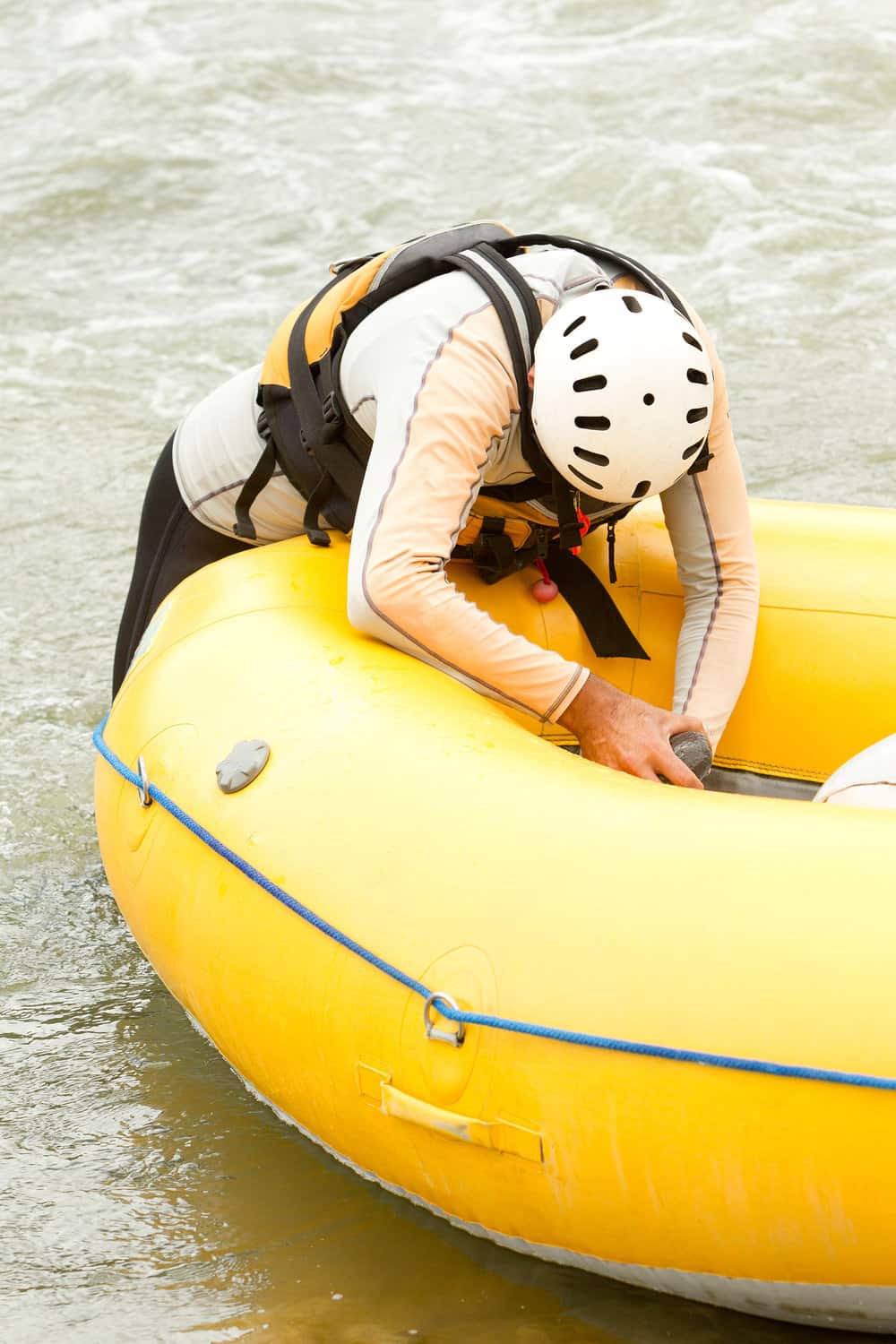“Steve, my boat won’t stop leaking. How do I fix it?”
It’s a question I get over and over and over again.
It’s a problem EVERY inflatable boat owner will experience eventually.
However, I never addressed this problem in-depth before.
That is… until now.
Today, I’m going to give you the most comprehensive guide for repairing your inflatable boat.
We’ll look at:
- How to repair PVC and Hypalon inflatables
- How to repair inflatable fabric tears that don’t leak
- How to repair a leaking valve
We’ll also cover how to find a leak, which type of glue to use for different materials, and more!
All this in layman’s terms – so you’ll never have to go to the professionals to get your boat fixed again.
Ready?
Let’s go.
Table of Contents
How to Permanently Repair an Inflatable Boat Step-by-Step
There’s nothing worse than the squealing noise of air leaking from your inflatable boat. You pump up the tubes, but they don’t stay solid. And it’s all because of
one
tiny
hole.
As annoying as it may be, this is all it takes to render your boat useless. That’s why knowing how to fix this small problem is so important.
The good news?
It’s not that hard.
With the right steps and a few DIY skills, everyone can get their boat back to life.
Which steps, you might ask?
Step 1: Find Leak
Finding a tiny hole can be very difficult.
Even if you inspect your boat closely and listen carefully, you might still miss it.
That’s why you should use soapy water.
With it, you’ll never miss the hole.
Inflate your boat, then spray soapy water all over. Escaping air will push against this layer of suds and create bubbles. It’s the fastest and easiest way to spot a leak.
Once you found it, mark the spot with a sharpie. Then deflate your boat and move to the next step.
Step 2: Prepare Patch
PVC and Hypalon (the two most popular inflatable materials) are both slippery. Without proper preparation, your patch is going to slide right off.
That’s why it’s important to roughen your patch before you get to gluing.
To roughen, scratch it with sandpaper until it loses its shine. Don’t do this too hard – you don’t want to remove a layer, you just want to remove its smoothness.
This way, your glue will have a much better “grip”.
Tip: Cut your patch in a circle! Rectangular patches tend to have flapped edges – which can easily be snagged off.
Don’t forget to also sand the area where you’ll apply the patch.
Step 3: Clean Boat
Next, you want to clean off the roughened area.
Dirty glue is the last thing you want. This creates a weak patch that won’t last long.
But here’s the tricky part…
PVC is plastic, while Hypalon is rubber. You’ll need a different type of cleaner for these two.
For PVC, use a plastic cleaner such as Plexus.
- Plexus seals the pores in plastic surfaces with a micro-thin layer of shiny, protective wax, making it resistant to debris, oil, scratches, and eventual yellowing
Last update on 2025-12-22 at 21:56 / Affiliate links / Images from Amazon Product Advertising API
While Hypalon goes well with toluene or acetone.
Tip: MEK, toluene, and acetone are hazardous materials. Wear proper safety gear and make sure you’re in a well-ventilated area when using these.
If in doubt, use rubbing alcohol. It won’t work as well, but at least you won’t damage your boat.
Step 4: Apply Glue
There are several critical things you need to know before applying glue.
One is that you need the right glue.
Again, PVC and Hypalon are very different from one another.
For PVC and other plastic inflatables (such as urethane), use something like Stabond
For Hypalon and rubber boats, NRS’s Hypalon glue will work perfectly
Tip: Most glues will work for either material. But for best results, use a glue made specifically for that material
Next, you need to cure the glue.
This isn’t an instant fix. It’s a long but permanent solution.
To properly repair your boat, you’ll need 3 layers of glue.
Tip: Read the instructions of your glue! Not all glues are the same, so stick with the manufacturer’s directions.
First, apply a thin layer of glue to both the boat and patch. Let it dry for around 30 minutes.
Then apply the second layer of glue. This time, let it sit for 10 minutes.
Finally, apply one more layer. Then wait 2-5 minutes for it to become tacky.
Tip: Use your knuckle to test your glue. Press your knuckle against the final layer of glue and remove it. If it’s ready, the tacky glue won’t stick to your knuckle.
Once that’s done, you’re now ready to apply the patch.
Step 5: Apply Patch
Now take your patch and slowly stick it to your boat.
Start from one side gently pressing it down, making sure no air bubbles get caught.
Once the whole patch is down, take a roller and flatten it completely.
Rolling seals the patch to the boat and removes any air bubbles you might have missed.
Step 6: Finish Up
Next, take a cloth and your cleaner (MEK, toluene, acetone, or alcohol) and wipe off any excess glue.
Tip: To make cleaning easier, you can surround the patch area with masking tape before applying glue.
Now, all there’s left to do is wait.
Give the glue at least 24 hours to harden.
If you’re not in a hurry, waiting for up to 3 days will ensure nothing goes wrong.
And that’s it! With these 6 easy steps, your inflatable boat will be as good as new again.
(Read more: How to clean the adhesive off of an inflatable boat?)
How to Repair Tears in Your Inflatable Boat
Not all hard hits cause punctures.
Sometimes, all it does are minor damages to your boat’s fabric – tearing away a piece of the outer layer.
If this happens, fix it immediately.
It’s not as bad as a leak, but it’s bound to get there. If you don’t fix it right away, it’ll let all the air out before long.
Fixing a tear is a little different from fixing a puncture. Yet the steps are basically the same…
Step 1: Sand
As always, a smooth surface won’t do.
Take sandpaper and scratch the damaged area. Scratch it up until it’s nice and rough.
Step 2: Glue
You’re not patching up your boat, so go directly into gluing.
For this type of repair, use a simpler type of glue – the type of glue you find in repair kits.
Glues such as Aquaseal are waterproof, durable, abrasion-resistant, and flexible. This allows them to blend right into your inflatable.
Tip: Before applying glue, use a marker to color the damaged area. Your boat will look much better if the tear isn’t obvious.
Spread an even amount on the damaged area and let it sit.
Step 3: Wait
All there’s left to do is wait for the glue to dry up.
How long depends on the type of glue you use. For Aquaseal, this will take 8-12 hours.
Other types of glue might dry up instantly – these are the types you want for emergency repairs on the water.
Always remember that this is ONLY for non-leaking issues. Once the air starts to get out, you’ll need a permanent patch for that.
How to Repair a Leaking Valve
Don’t you hate that feeling of despair when you find out your valve is leaking?
It’s one thing to patch a puncture, it’s quite another to repair a leaking valve. These are complex mechanisms that – it may seem to you – require a professional to fix.
But here’s the shocking thing…
Fixing a leaking valve is super easy.
All you need to know is why the valve is leaking.
With that, the solutions are simple…
Solution 1: Tightening
A lot of times, the problem is as simple as a loose valve.
Once you’ve identified that your valve is leaking (by spraying soapy water on it), try tightening it before anything else.
Take your valve wrench and tighten it up.
Don’t have a valve wrench? Get one on Amazon.
Solution 2: Cleaning
Didn’t work?
It could be some sand or dirt got caught in the threads. This makes it impossible to get an air-tight seal.
With your wrench, completely remove the valve and inspect it. Then take some soapy water and clean it off.
If dirt was the issue, this should solve your problem.
Solution 3: More Cleaning
What if the leak isn’t coming from the base of the valve, but rather from the pushpin?
Instead of replacing your valve right away, try the harmless method that works 99% of the time… cleaning… again.
Take soapy water, and force spray it into the valve. This should flush out any dirt that got in there.
Tip: Use a cotton earbud to really get in there and clean it up.
Can’t force water through?
Remove the entire valve and clean that.
This allows you to get to the area where the rubber meets the plastic. Flush it with soapy water and use a cotton bud to make it spotless.
After this, there’s no way dirt can be the issue anymore.
Solution 4: Replacing
If all else fails, you need new parts.
Cleaning is great because even if it doesn’t work, you’ll at least see what the problem is. You might find that the issue is with the rubber… or maybe it’s the plastics.
This way, you can buy a replacement for the damaged part only – saving you cash.
Can’t find any specific parts for sale? Buy an entire valve instead.
Here’s how to replace your valve:
Conclusion
And there you have it!
Next time your inflatable starts losing air, you’ll know exactly what to do.
You can save A LOT now – you won’t need professional help anymore.
So get your hands dirty and repair your inflatable boat today!
Didn’t find what you were looking for? Leave a comment down below!

I created this site to help people – to help you – with your boat problems. Instead of helping one person at a time, I want this website to be the “one-stop-shop” for everyone’s boating concerns. Read more.









Rosie
Tuesday 4th of October 2022
Hi, How d you repair a leak from a seam on the top side of a dinghy please? EXCEL SD230 model. Ours has not been used for a while and the seam appears to be where the leak is coming from. Not a hole in the dignhy structure but under the seam. Any ideas please? Many thanks. Rosie & Steve - Spain